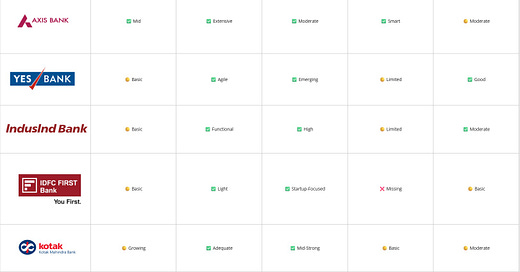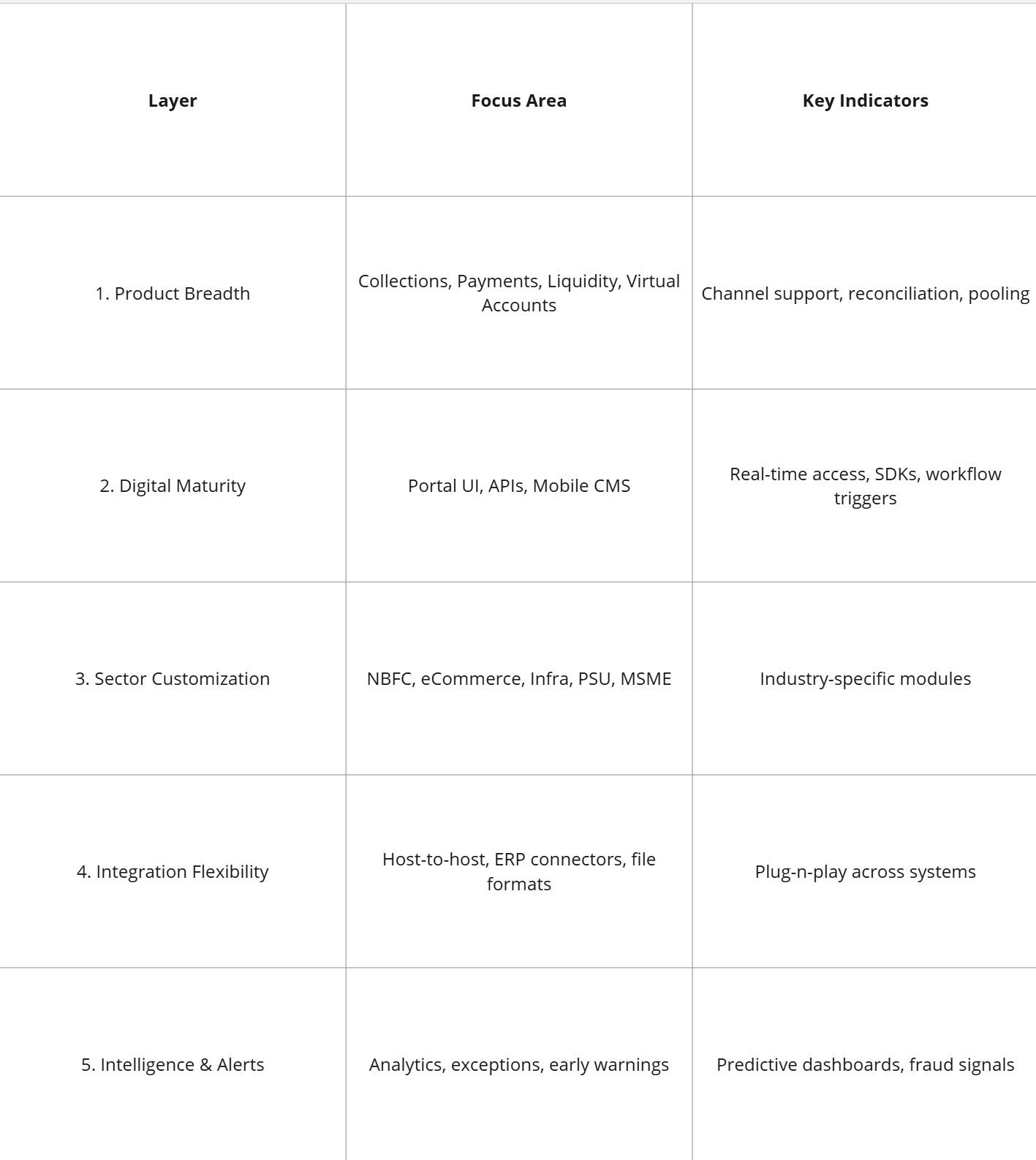After exploring dashboard intelligence in Chapter 2, this chapter focuses on granular, bank-wise analysis of CMS capabilities across India's leading private and public sector institutions.
Each bank operates within a unique strategic context, serving different industries, scales of enterprise, and CMS maturity. Here, we evaluate each bank’s CMS proposition using a 5-Layer Evaluation Framework that captures digital readiness, product spread, integration flexibility, analytics depth, and customer experience.
🧩 The 5-Layer CMS Capability Evaluation Framework
🏦 Bank-Wise Deep Dives
🔹 HDFC Bank
Strength: Breadth of CMS products with sector-wide customization
Highlights:
Industry-leading virtual accounts and pooling mechanisms
Real-time dashboards with API integrations
High adoption among NBFCs, corporates, and aggregators
Scope for Growth: Real-time fraud alerts and anomaly detection
🔹 ICICI Bank
Strength: API-first architecture and smart reconciliation engine
Highlights:
Customizable cash pickup/drop schedules
Dynamic UPI and QR collection models
Sector-specific portals for logistics, PSUs, and fintech’s
Scope for Growth: Front-end UX for CMS dashboard lags slightly behind peers
🔹 Axis Bank
Strength: Flexible integration capabilities across CMS modules
Highlights:
Rich host-to-host options and smart liquidity tools
Sectoral CMS packs for Retail, eComm, and Infra
Notable CMS adoption in renewable energy and mid-sized NBFCs
Scope for Growth: Limited innovation in predictive CMS analytics
🔹 YES Bank
Strength: Modular CMS platform architecture
Highlights:
Plug-and-play APIs with instant onboarding
Focus on startups, aggregators, and digital-first businesses
Effective dashboard-level role permissions
Scope for Growth: Requires deeper reconciliation automation
🔹 IndusInd Bank
Strength: Payments and Escrow-focused CMS with real-time adaptability
Highlights:
Exceptionally detailed payment suite
High focus on structured disbursements for NBFCs and supply chains
Scope for Growth: More sectoral dashboards and liquidity tools needed
🔹 IDFC FIRST Bank
Strength: Clean UI, fast adoption cycles for digital-first clients
Highlights:
Agile CMS for SMEs and D2C brands
Smooth file-based processing and basic API sets
Scope for Growth: Lacks advanced pooling or fraud detection modules
🔹 Kotak Mahindra Bank
Strength: Sector-led product structure with stable CMS offerings
Highlights:
Portal-driven CMS built for growth-stage corporates
Moderate analytics tools with clear flows for finance teams
Scope for Growth: Broader file type acceptance and AI-led forecasts
📈 Comparative Snapshot: CMS Feature Maturity Matrix
🛠️ Actionable Insights for Product Teams
NBFC-focused banks (e.g., IndusInd, HDFC) should strengthen early alert systems and predictive pooling to manage large volumes.
Mid-tier banks (e.g., Kotak, IDFC FIRST) can gain edge through sector-focused CMS bundles with low-code onboarding.
Banks with strong APIs (e.g., ICICI, YES) should scale their UI/UX layer to provide parity across channels.
Analytics differentiation is a clear whitespace — no bank today offers truly predictive exception handling in CMS.
🏁 Conclusion: Bank CMS is Becoming a Product, Not Just a Service
The future of CMS is productized. The banks leading the CMS race in India are those who combine modular APIs, dashboard-level personalization, and sector-specific depth. With embedded finance models rising, CMS offerings must become more than utilities — they must evolve into intelligent platforms.







